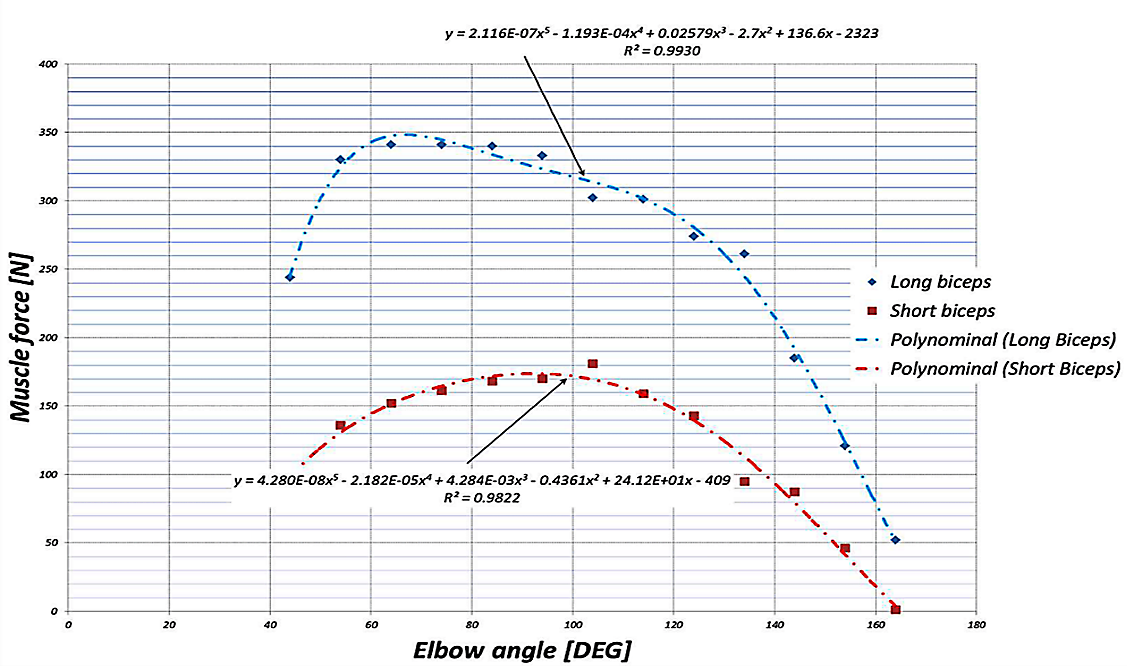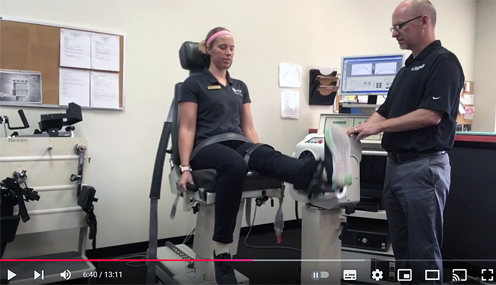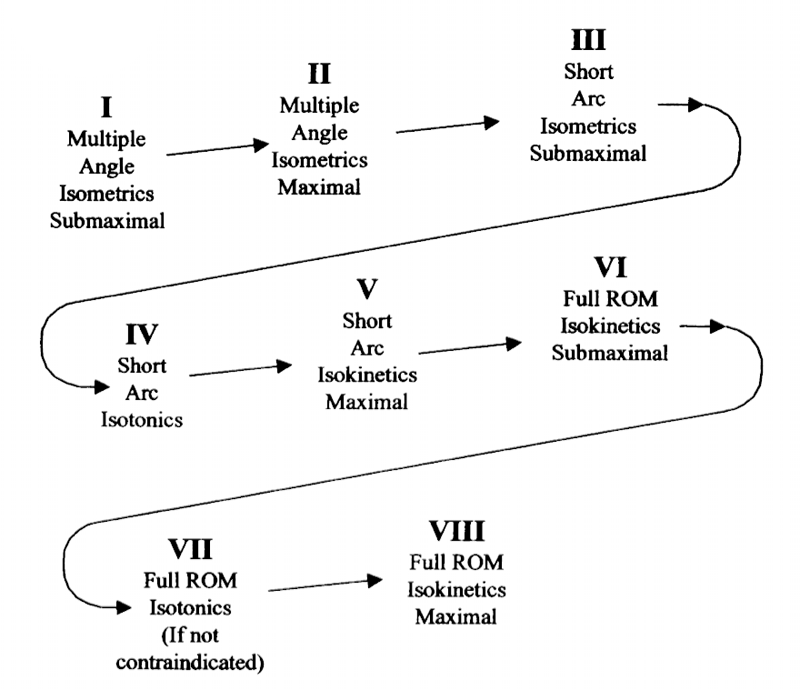You are viewing 1 of your 1 free articles. For unlimited access take a risk-free trial
Injury rehab: taking a smooth approach
When injury strikes, speedy rehabilitation is critical to minimize fitness losses. With that in mind, SPB looks at the evidence for the benefits of using isokinetic strength training when athletes are in rehab, and how to apply the findings for faster recovery
Getting the best out of your training to produce maximum fitness and performance gains is a complex process. As regular readers will already know, research has identified endless permutations of training approaches that can be utilized to deliver ultimate performance and blending these together in a carefully designed program, supported by optimum nutrition is absolutely essential for success. When injury strikes however, even the most meticulously planned program amounts to nothing. As that heard-earned fitness slips away, the overriding requirement is to speed injury healing and then rehab the athlete back to fitness as fast as possible! With that in mind, one of the most important goals of athletes (and their coaches and trainers) should be firstly, to try and prevent the occurrence of injury, and secondly, to understand how to rehabilitate any injury that does occur as rapidly as fully as possible.
Speed, resistance and distance
When it comes to injury rehab, the use of strength and conditioning is an absolutely crucial tool in the box. Using strength and conditioning exercises can not only help build muscle and tendon strength and resilience, it can also help eliminate any biomechanical imbalances that may have contributed to the injury in the first place. Muscular overload is necessary for any strength and conditioning protocol (all of which require the application of external resistance), and there are many ways to achieve this. In broad-brush terms, the applied resistance can be categorized as follows:
· Isotonic – muscles work against constant weight/loading (eg lifting free weights or using machine weights).
· Isometric – muscles work at a constant (fixed) position regardless of load (eg core strengthening exercises such as holding a static plank position).
· Isokinetic – muscles work at a constant velocity regardless of load. No matter how hard you exert force, the speed of movement of the muscle being used remains the same.
In most strength and conditioning settings, isotonic loading is employed thanks to the ubiquitous use of free and machine weights, which are conveniently adjusted and relatively inexpensive. However, in theory at least, isokinetic (sometimes called ‘isovelocity’) training devices offer some distinct advantages. In particular, isokinetic training allows maximum tension and loading to be applied to a muscle at all points through its range of motion; this is in contrast to conventional resistance (isotonic training), where the loading has to be chosen for a particular range of motion, meaning that at other points in the movement, the loading is less than optimal. An example of this is biceps curls, where, due to the physics of levers and muscle architecture, the muscles can exert high levels of force in the 60-120 degree range, but far less above and below this movement range (see figure 1).
Figure 1: Elbow angle and muscle force during biceps curls*
Red plot = short biceps force; blue plot = long biceps force. Adding the two gives total force, which is maximized in the 60-120 degree range. *NB: data from Urquijo et al, Mathematics 2022, 10(14), 2441; doi.org/10.3390/math10142441
Perhaps more significantly in an athletic context, isokinetic loading allows maximal force to be developed at various limb speeds, and at high velocities. In isotonic loading, limb movement rarely exceeds 60 degrees/second; however, in most functional sporting movements, limb movement exceeds 90 degrees/second, with some movements exceeding 200 degrees/second(1). Another potential advantage of isokinetic loading is the ability to measure and monitor the relationship between joint angle and force produced. This information can provide trainers and physios with considerable insight into how effective/resilient a joint is under load, particularly in relation to the functional demands of a particular sport.
Isokinetic strength training in rehab
There’s no doubt that in terms of functional sports strength, isokinetic training can deliver potential advantages, particularly for high-velocity limb movements such as throwing and sprinting. But what about its role in injury rehab? Is isokinetic training an effective protocol for injury rehabilitation and does it provide additional benefits above and beyond those derived from conventional resistance training? Very few studies have directly compared the use of isokinetic vs. isotonic training protocols for injury rehab, but there’s certainly some evidence for the benefits of isokinetic training.
In a 2019 study, Chinese researchers investigated the effect of isokinetic training on knee function and graft remodelling (knitting together of tissue) after anterior cruciate ligament (ACL) reconstruction(3). In this study, 40 patients who had undergone arthroscopic ACL reconstruction using hamstring tendon were randomly divided into two groups:
· Isokinetic post-operation training group
· Control group (who trained using conventional isotonic resistance methods post-operation)
Importantly, there was no significant difference in gender, age, body mass index, side of injury, the interval between injury and operation, and the severity of the injury (assessed using internationally recognized criteria) prior to the operation.
Both groups of patients underwent staged rehabilitation treatment; however, the isokinetic group replaced the traditional intervention with the corresponding isokinetic strength training in the 3- to 6-month period post operation, while the traditional rehabilitation intervention was used in the control group. The peak torque (PT) of knee extension and flexion and hamstring quadriceps ratio (H/Q) were measured at three, six and twelve months post op, and MRI scans were also carried out to assess graft remodelling (basically the amount of healing). A further arthroscopy (where a small camera is inserted into the knee) was performed at 24 months post operation to assess the shape, tension, and how well the grafts has developed their own blood supply (more technically known as ‘vascularization’). The results were as follows:
· At the 24-month arthroscopy, the tissue healing score was 90.45 in isokinetic group and 89.32 in control group – both significantly improved compared with preoperative scores but not significantly different between the two groups. However, the cell structure in the isokinetic group was superior to that of the control group.
· At six and 12 months, the peak torque figures of knee extension and flexion in isokinetic group were higher than those in control group.
· The H/Q ratio scores at 6 and 12 months were higher in isokinetic group than in control group.
· There was no significant difference in MRI scores between the two groups at 3 and 6 months, but the MRI scores at 12 months were significantly higher in isokinetic group.
In their summary, the researchers concluded that ‘using an isokinetic training system for a post-surgical rehabilitation training program was helpful in early muscle strength recovery, early graft remodelling, and longer-term tissue structure results after ACL reconstruction’.
In another study on the use of isokinetic training for rehab following ACL reconstruction (also published in 2019), Brazilian researchers compared the effects of conventional (constant load) eccentric training and isokinetic eccentric training on quadriceps muscle mass, strength and functional performance in recreational athletes following anterior cruciate ligament (ACL) reconstruction(4). To do this, 30 recreational male athletes (average age 25 years old) undergoing ACL reconstruction received a standard rehabilitation program. However, before rehab commenced, the athletes were randomized to either conventional rehab group (who performed conventional isotonic weight training on an leg extension machine) or an isokinetic group (who performed isokinetic training using an isokinetic dynamometer - see figure below).
Figure 2: Using an isokinetic dynamometer for hamstring/quadriceps training and testing
Both groups performed two sessions per week of rehab training for a period of six weeks. Assessments of quadriceps muscle mass (using MRI), strength (through isokinetic dynamometry) and self-awareness functionality (via a questionnaire) were performed before and after the training programs. Single leg hop test performance was assessed only at post-training evaluation. The results showed that the isokinetic-trained subjects experienced greater improvements than the conventional subjects for all muscle mass outcomes (an average of 17-23% gains in the isokinetic group vs. 5-9% in the conventional group). The same was true for peak torque improvements. The isokinetic vs. conventional gains were +34% vs. +20% for isometric peak torque and 85% vs. +23% for eccentric peak torque. Interestingly however, there was no between-group difference for concentric peak torque or single leg hop test scores.
Analysing movement patterns and injury rehab
Most dedicated isokinetic resistance machines generate resistance electronically. By adding motion and force sensors and a computer interface, athletes can use them both to build strength and power, and to analyse movement and ‘force curve’ patterns, which can be very useful for athletes or sportsmen and women. For example, suppose a runner with a history of knee injuries wanted to investigate how efficiently their frontal thigh muscles (quadriceps) were working. By performing a set of reps on an isokinetic machine, he or she could draw up a force-power curve, displaying exactly how much force the muscles were producing at every single point throughout the range of movement.
This can be very useful in injury rehab, where muscles may need to be worked through a particular range of movement to rehabilitate an injury, protect against re-injury or (in conjunction with other muscle groups) to help produce a more biomechanically balanced pattern of movement to protect against chronic overuse injuries. This kind of analysis is also extremely valuable in sports performance. Front crawl swimmers for example need a long stroke through the water and must be able to push hard, even right at the end of the stroke before the hand leaves the water. Force-power curves from an isokinetic machine can analyse how effective the lats of the back and the triceps of the upper arm are at producing force through that range of movement.
Partial meniscectomy and quadriceps strength
Another study suggests that isokinetic eccentric training may be more effective than constant-load eccentric training in rehab – this time for quadriceps rehabilitation following a partial meniscectomy (removal of damaged meniscus cartilage tissue under the knee cap)(5). In this study, 32 recreational male athletes (average age 27 years old) who had undergone a partial meniscectomy performed a 6-week quadriceps strength training program. Before the rehab training however, the athletes were randomized into two groups: conventional-load training group or an isokinetic training group. Before and after the rehab program, all the athletes were assessed for quadriceps muscle mass, strength, and their progress in terms of objective and self-reported function.
As expected, both rehab groups experienced enhanced muscle mass, strength and functionality outcomes over the 6-week intervention period. However, the isokinetic group experienced significantly greater gains in muscle mass, muscle strength and Lysholm knee-scoring scale (a widely used scale to assess knee symptoms and function). The researchers unsurprisingly concluded that, following a partial meniscectomy, isokinetic eccentric training is more effective than conventional eccentric training to restore quadriceps muscle mass, strength, and functional capacity.
Utilising isokinetic training in practice
While there have been many studies in the literature looking into the use of isokinetic training as a mode of strength training or assessment, data from direct comparisons between isokinetic and isotonic strength training in properly controlled athlete injury rehab studies is extremely limited. This makes it difficult to draw definitive conclusions about its applying it in practice. However, given the evidence we do have, if an isokinetic training option can be provided, athletes and their coaches & trainers should feel confident that it is at least as good an alternative to isotonic/isometric training, if not superior.
The relative lack of research means that evidence-based specific guidelines for athletes wishing to perform isokinetic training during rehab are limited. A full discussion of this topic is beyond the scope of this article, but an excellent review study on this topic by Ellenbecker and Davies can be found here. In this paper, an 8-stage approach is deployed, beginning with sub-maximal isometric exercises and short-arc isotonic exercises, before isokinetic training is introduced at stage 5 (see figure 3)(6).
Figure 3: Stages of Ellenbecker and Davies’ resistive exercise progression continuum
Isokinetic training is introduced into rehab at stage 5, following appropriate isometric (fixed-position) and short range of motion isotonic (ie normal weight) training. Note that stage 8 involves full range of motion (ROM) isokinetic training, providing a further level of training adaptation above and beyond full range isotonic training.
‘Short-arc’ exercises are often started using slower speed isokinetics, making them safe for the athlete’s healing tissue. Velocities in short-arc isokinetics should range from 60 to 180 degrees/second. Velocities slower than 60 degrees/second are not recommended; they increase joint compressive forces and often create inhibition responses. Meanwhile, velocities greater than 180 degrees/second for short-arc isokinetic exercises create too large a range of free-limb acceleration, resulting in insufficient loading of the muscles.
Athletes and coaches should also be aware that isokinetic exercise contains three major components: acceleration, deceleration, and effective ‘load range’. The load range is the actual portion of the range of motion in which the preset angular velocity is met by the athlete and a true isokinetic load is imparted to the athlete. A patient will experience a larger load range at slower contractile velocities, with a statistically shorter load range at faster contractile velocities(7). When setting the range of motion for an isokinetic exercise, the acceleration and deceleration components must be factored in, which means a greater range of motion than may be expected will be required.
Summary
If injury does strike and you want the fastest path to rehab/return to sport, the evidence suggests that isokinetic training could offer a superior alternative to more conventional resistance training modes. This doesn’t mean that conventional resistance training is not productive – far from it. It’s just that performing isokinetic resistance training seems to deliver even better results. The problem for many athletes however is getting access to isokinetic training devices, as they are not widely used in most commercial gyms. It maybe that a mixed approach is required, with a trip to a facility where isokinetic training devices are available once or maybe twice per week and the rest of the rehab work carried out using conventional resistance training. Either way, it’s important to remember that when incorporating any isokinetic training into a rehab strength training program, a staged approach starting with low-range isotonic and isometric exercises is recommended!
References
1. Med Sci Sports 1975; vol 7(4) 262-274
2. Br J Sports Med 2002;36:370–374
3. Zhongguo Xiu Fu Chong Jian Wai Ke Za Zhi. 2019 Sep 15;33(9):1088-1094
4. Braz J Phys Ther. 2019 Jul 16. pii: S1413-3555(19)30009-7
5. Phys Ther Sport. 2019 Jul 18;39:120-125
6. Journal of Athletic Training 2000;35(3):338-350
7. J Strength Condition Res. 1995;9:160-164
Newsletter Sign Up
Testimonials
Dr. Alexandra Fandetti-Robin, Back & Body Chiropractic
Elspeth Cowell MSCh DpodM SRCh HCPC reg
William Hunter, Nuffield Health
Newsletter Sign Up
Coaches Testimonials
Dr. Alexandra Fandetti-Robin, Back & Body Chiropractic
Elspeth Cowell MSCh DpodM SRCh HCPC reg
William Hunter, Nuffield Health
Keep up with latest sports science research and apply it to maximize performance
Today you have the chance to join a group of athletes, and sports coaches/trainers who all have something special in common...
They use the latest research to improve performance for themselves and their clients - both athletes and sports teams - with help from global specialists in the fields of sports science, sports medicine and sports psychology.
They do this by reading Sports Performance Bulletin, an easy-to-digest but serious-minded journal dedicated to high performance sports. SPB offers a wealth of information and insight into the latest research, in an easily-accessible and understood format, along with a wealth of practical recommendations.
*includes 3 coaching manuals
Get Inspired
All the latest techniques and approaches
Sports Performance Bulletin helps dedicated endurance athletes improve their performance. Sense-checking the latest sports science research, and sourcing evidence and case studies to support findings, Sports Performance Bulletin turns proven insights into easily digestible practical advice. Supporting athletes, coaches and professionals who wish to ensure their guidance and programmes are kept right up to date and based on credible science.













